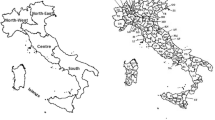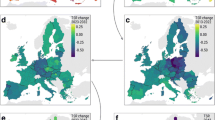Abstract
While population ageing is considered a ‘major concern’ by over half the governments worldwide according to the UN and ‘the most important population issue for the ensuing two decades’ by a 2012 survey of leading demographers, research into population ageing and its causes at a sub-national level has only emerged more recently. This paper introduces a model for identifying the factors influencing the change in the mean age of a population. Through decomposition the model identifies how, and to what extent, each component of demographic change (fertility, mortality, overseas migration and interstate migration) contributes to the overall change in the mean age of the population over a given period. The paper uses the State of Tasmania, Australia to quantify, for the first time, the difference between national and sub-national population ageing. It finds that from 2005 to 2015, Tasmania’s predicted mean age increased by an average of 0.222 years per annum compared with 0.108 years per annum for Australia. This differential of 0.114 years is largely explained by the ageing effect of interstate migration, averaging 0.073 years per annum, which is not relevant at a national level. The paper confirms that as regional differences between fertility and mortality levels within a nation are usually small, it is migration which is predominantly responsible for different changes in the mean age of the population between national and sub-national levels.

Source: ABS Australian Demographic Statistics, Cat. No. 3101.0; Migration, Australia, Cat. No. 3412.0; Births, Australia, Cat. No. 3301.0; Deaths, Australia, Cat. No, 3302.0, various years, author’s calculations

Source: ABS Australian Demographic Statistics, Cat. No. 3101.0; Migration, Australia, Cat. No. 3412.0; Births, Australia, Cat. No. 3301.0; Deaths, Australia, Cat. No, 3302.0, various years, author’s calculations

Source: ABS Australian Demographic Statistics, Cat. No. 3101.0; Migration, Australia, Cat. No. 3412.0; Births, Australia, Cat. No. 3301.0; Deaths, Australia, Cat. No, 3302.0, various years, author’s calculations
Similar content being viewed by others
Notes
Numerical ageing refers to the absolute increase in the number of elderly and is primarily caused by improvements in life expectancy.
Structural ageing refers to the increase in the proportion of the population that is older and is primarily caused by declining fertility rates at a national level.
The original derivation of this formula is provided in Preston et al. (1989: 703: "Appendix"). The formula is further adapted in Káčerová et al. (2013).
For overseas migration, the upper age band is 65 years and older, for interstate migration, the upper age band is 75 years and older.
For inward and outward migration (both overseas and interstate) the upper limit is assumed to be 85 years.
References
Atkins, M. T., & Tonts, M. (2016). Exploring cities through a population ageing matrix: A spatial and temporal analysis of older adult population trends in Perth, Australia. Australian Geographer, 47(1), 65–87.
Australian Bureau of Statistics. (2008). Population projections, Australia, 2006 to 2101. Canberra: ABS.
Australian Bureau of Statistics. (2013). Population projections, Australia, 2012 (base) to 2101. Canberra: ABS.
Australian Bureau of Statistics. (2016). Australian Demographic Statistics, Jun 2016. Population by age and sex tables. Canberra: ABS.
Blake, S. (2009). Subnational patterns of population ageing. Population trends (Vol. Summer 2009). UK: Office for National Statistics.
Bucher, H., & Mai, R. (2005). Depopulation and its consequences for the regions of Europe. DG III—social cohesion. Brussels.
Carmichael, G. A. (2016). Fundamentals of demographic analysis: Concepts, measures and methods (Vol. 38, The Springer Series on Demographic methods and population analysis). Switzerland: Springer International Publishing.
Churchill, B., Denny, L., & Jackson, N. (2014). Thank god, you’re here: The coming generation and the role they will play in future-proofing Australia from the challenges of population ageing. Australian Journal of Social Issues, 49(3), 373–392.
Commonwealth of Australia (2002). Intergenerational report 2002-03: Budget paper no. 5. Canberra: Commonwealth of Australia.
Commonwealth of Australia. (2007). Intergenerational report 2007. Canberra: Commonwealth of Australia.
Commonwealth of Australia. (2010). Intergenerational report 2010: Australia to 2050: Future Challenges. Canberra: Commonwealth of Australia.
Commonwealth of Australia (2015). 2015 Intergenerational report Australia in 2055. (Vol. 12). Canberra
Denny, L. (2015). Tasmania’s population challenge: 650,000 by 2050. Tasmania: Background Issues Paper.
Edmonston, B. (2009). Canadian provincial population growth: Fertility, migration, and age structure effects. Canadian Studies in Population, 36(1–2), 111–144.
Haartsen, T., & Venhorst, V. (2010). Planning for decline: Anticipating on population decline in the Netherlands. Tijdschrift Voor Economische en Sociale Geografie, 101(2), 218–227.
Hugo, G., Harris, K., Bell, M., Spoehr, J., & Coffee, N. (2000). ‘Bringing them back home’: Factors influencing interstate migration to and from South Australia. Migration, 1991, 96.
Jackson, N. (2014). Sub-national depopulation in search of a theory-towards a diagnostic framework. New Zealand Population Review, 40, 3.
Jackson, N., & Kippen, R. (2001). Whither Tasmania? A note on Tasmania’s population problem. People and Place, 9(1), 27–37.
Jackson, N., & Thompson, B. (2002). Population ageing and the ABC of educational demand. A focus on Tasmania and South Australia. People and Place, 10(3), 11–22.
Jackson, N., & Wilde, P. (2010). Migration trends in Tasmania. Demographic Change Advisory Council.
Káčerová, M., Ondačková, J., & Mládek, J. (2013). Contribution of population processes to population ageing: A comparison of the Czech and Slovak Republics. Acta Universitatis Palackianae Olomucensis-Geographica, 44(1), 27–43.
Lutz, W., Sanderson, W., & Scherbov, S. (2008). Global and regional population ageing: How certain are we of its dimensions? Journal of Population Ageing, 1(1), 75–97. https://doi.org/10.1007/s12062-009-9005-5.
Notestein, F. (1950). The Population of the world in the year 2000. Journal of the American Statistical Association, 45(251), 335–345.
O’Brien, E. (2015). Planning for population ageing: Implications of local demographic, spatial and fiscal differences. International Planning Studies, 1–12.
Poulain, M. (1989). Interactions between population ageing and internal migration. ACTA Demographica, 9(3), 326–336.
Preston, S. H., Himes, C., & Eggers, M. (1989). Demographic conditions responsible for population aging. Demography, 26(4), 691–704.
Rowland, D. (2003). Demographic methods and concepts. Oxford: Oxford University Press.
Siddiq, F., & Babins, S. (2013). Trends in population growth: Inequality across subnational jurisdictions in Canada. Canadian Public Policy, 39(Supplement 1), S41–S64.
Smailes, P., Griffin, T., & Argent, N. (2014). Demographic change, differential ageing, and public policy in rural and regional Australia: A three-state case study. Geographical Research, 52(3), 229–249.
South Australian Government (2004). Prosperity through people: A population policy for South Australia. Adelaide.
Tasmanian Government. (2015). Population growth strategy: Growing Tasmania’s population to 650 000 by 2050. Tasmania: Department of State Growth.
United Nations. (2013a). World population ageing 2013. New York: Department of Economic and Social Affairs, Population Division.
United Nations. (2013b). World population policies 2013. New York: Department of Economic and Social Affairs, Population Division.
Van Dalen, H. P., & Henkens, K. (2012). What’s on a demographer’s mind? A world-wide survey. Demographic Research, 26, 363–406.
Yusuf, F., Martins, J. M., & Swanson, D. A. (2014). Methods of demographic analysis. Netherlands: Springer.
Acknowledgements
Sincere thanks and gratitude go to Professor Martin Bell and Dr Tom Wilson for their invaluable comments and support of this paper as well as the extensive feedback provided by two anonymous reviewers.
Author information
Authors and Affiliations
Corresponding author
Rights and permissions
About this article
Cite this article
Denny, L. Decomposition: population ageing at a sub-national level using Tasmania, Australia as a case study. J Pop Research 35, 151–167 (2018). https://doi.org/10.1007/s12546-018-9201-3
Published:
Issue Date:
DOI: https://doi.org/10.1007/s12546-018-9201-3




